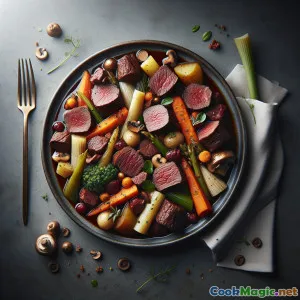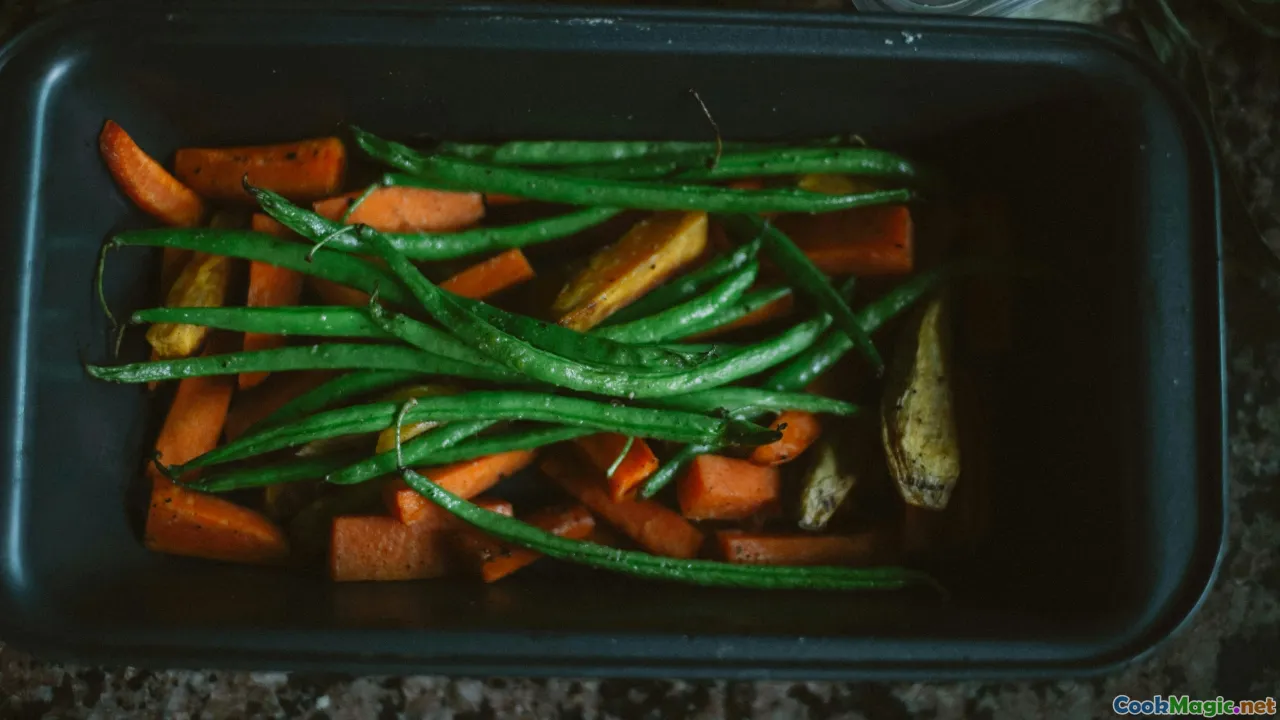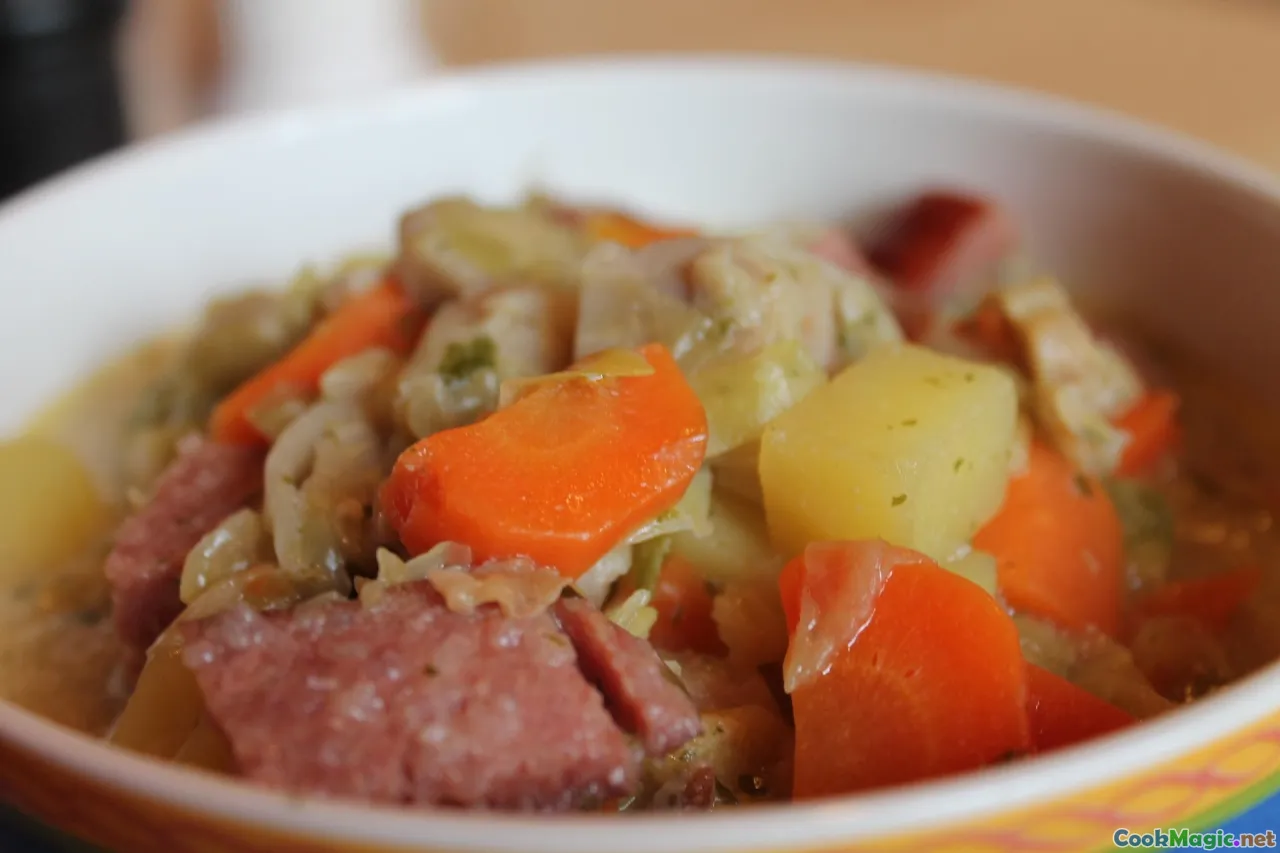
Ensopado Imperial de veado com glacê de vinho rubi
(Imperial Venison Stew with Ruby Wine Glaze)
(0 Avaliações)0
366
novembro 08, 2025
Reportar um problema
Ingredientes
-
900 grams Ombro de veado, aparado e cortado em cubos
(Cut into 3–4 cm pieces; remove silver skin for tenderness)
-
120 grams Pancetta defumada ou bacon em tiras, picado
(Adds depth and gentle smokiness)
-
2 tbsp Farinha de trigo comum
(Light dredge for venison to aid browning and body)
-
2 tbsp Azeite
(For searing)
-
2 tbsp Manteiga sem sal
(Enriches the stew at the finish)
-
200 grams Cebolinhas-perola ou chalotas pequenas, descascadas
(Left whole for luxurious texture)
-
200 grams Cenouras, em pedaços
(Cut into 2–3 cm pieces)
-
150 grams Pastinaga, cortada em cubos
(Sweet and earthy contrast)
-
100 grams Aipo, picado
(Aromatics Base)
-
200 grams Cogumelos castanhos ou de botão, cortados em quartos
(Sauté separately for best texture)
-
4 cloves Alho (picado)
(Freshly minced)
-
2 tbsp Extrato de tomate
(Caramelize to build umami)
-
15 grams Cogumelos porcini secos
(Soak in ~200 ml boiling water; strain and reserve liquid)
-
250 ml Vinho tinto encorpado
(Bordeaux, Rioja, or similar)
-
750 ml Caldo de carne de boi ou caça, baixo teor de sódio
(Combine with strained porcini liquid)
-
2 tbsp Geleia de groselha vermelha
(Classic British gloss and gentle tang)
-
1 tbsp Vinagre de sidra
(Balances richness at the end)
-
6 whole Bagas de zimbro, levemente esmagadas
(Signature game aroma)
-
2 leaves Folhas de louro
(Fragrant backbone)
-
4 sprigs Ramos de tomilho fresco
(Tie with rosemary for easy removal)
-
1 sprig Alecrim fresco
(Sturdy, resinous note)
-
1.5 tsp Sal grosso kosher
(Ajuste a gosto)
-
1 tsp Pimenta-do-reino moída na hora
(Ajuste a gosto)
-
10 grams Chocolate amargo (70%)
(Shaved; adds silkiness and depth)
-
1 tsp raspa de laranja finamente ralada
(Brightens the finish)
-
2 Berries Pimenta-da-Jamaica inteira
(Subtle warm spice)
-
10 grams Salsa de salsinha de folha plana, picada
(Para guarnição)
(Cut into 3–4 cm pieces; remove silver skin for tenderness)
(Adds depth and gentle smokiness)
(Light dredge for venison to aid browning and body)
(For searing)
(Enriches the stew at the finish)
(Left whole for luxurious texture)
(Cut into 2–3 cm pieces)
(Sweet and earthy contrast)
(Aromatics Base)
(Sauté separately for best texture)
(Freshly minced)
(Caramelize to build umami)
(Soak in ~200 ml boiling water; strain and reserve liquid)
(Bordeaux, Rioja, or similar)
(Combine with strained porcini liquid)
(Classic British gloss and gentle tang)
(Balances richness at the end)
(Signature game aroma)
(Fragrant backbone)
(Tie with rosemary for easy removal)
(Sturdy, resinous note)
(Ajuste a gosto)
(Ajuste a gosto)
(Shaved; adds silkiness and depth)
(Brightens the finish)
(Subtle warm spice)
(Para guarnição)
Nutrição
- Porções: 6
- Tamanho da Porção: 1 hearty bowl (350–400g)
- Calories: 585 kcal
- Carbohydrates: 0 g
- Protein: 48 g
- Fat: 24 g
- Fiber: 6 g
- Sugar: 9 g
- Sodium: 980 mg
- Cholesterol: 145 mg
- Calcium: 110 mg
- Iron: 8.9 mg
Instruções
-
1 - Pat dry and season venison:
Blot venison cubes very dry with paper towels. Toss with 1 tsp salt and 1/2 tsp pepper. Dust lightly with flour, shaking off excess; this promotes browning and a silky sauce.
-
2 - Soak porcini:
Cover dried porcini with about 200 ml boiling water. Steep 10 minutes, then strain through a fine sieve or coffee filter to remove grit. Reserve the aromatic liquid.
-
3 - Render pancetta and sear venison:
Heat olive oil in a heavy Dutch oven over medium-high. Render pancetta until lightly crisp; remove and reserve. In the fat, sear venison in batches until deeply browned on all sides. Do not overcrowd.
-
4 - Sweat aromatics:
Reduce heat to medium. Add pearl onions, carrots, celery, and a pinch of salt; cook 5–7 minutes, stirring. Add garlic and cook 1 minute until fragrant.
-
5 - Build the fond:
Stir in tomato paste and cook 2–3 minutes until brick-red. Splash a little wine to deglaze, scraping browned bits. Return venison and pancetta to the pot.
-
6 - Add Liquids and Spices:
Pour in remaining wine, stock, and the strained porcini liquid. Add soaked porcini, bay, thyme, rosemary, juniper, and allspice (if using). Bring to a gentle simmer.
-
7 - Low, slow braise:
Cover and cook at a bare simmer on the stovetop or in a 160°C (320°F) oven for about 1 hour 45 minutes, until venison is fork-tender and sauce lightly thickened.
-
8 - Sauté Mushrooms:
Near the end, pan-sear mushrooms in 1 tsp oil or butter until browned and nutty. Season with a pinch of salt. This keeps them meaty, not waterlogged.
-
9 - Finish and balance:
Fold mushrooms into the stew with redcurrant jelly and cider vinegar. Swirl in butter. Add dark chocolate and orange zest if using. Simmer 3–5 minutes to gloss.
-
10 - Adjust and rest:
Taste and adjust salt and pepper. Remove herb stems and bay. Let the stew rest off heat 5 minutes to settle flavors and thicken naturally.
-
11 - Garnish and Serve:
Ladle into warm bowls. Scatter chopped parsley. Serve with buttered mash, crusty bread, or herbed dumplings.
Blot venison cubes very dry with paper towels. Toss with 1 tsp salt and 1/2 tsp pepper. Dust lightly with flour, shaking off excess; this promotes browning and a silky sauce.
Cover dried porcini with about 200 ml boiling water. Steep 10 minutes, then strain through a fine sieve or coffee filter to remove grit. Reserve the aromatic liquid.
Heat olive oil in a heavy Dutch oven over medium-high. Render pancetta until lightly crisp; remove and reserve. In the fat, sear venison in batches until deeply browned on all sides. Do not overcrowd.
Reduce heat to medium. Add pearl onions, carrots, celery, and a pinch of salt; cook 5–7 minutes, stirring. Add garlic and cook 1 minute until fragrant.
Stir in tomato paste and cook 2–3 minutes until brick-red. Splash a little wine to deglaze, scraping browned bits. Return venison and pancetta to the pot.
Pour in remaining wine, stock, and the strained porcini liquid. Add soaked porcini, bay, thyme, rosemary, juniper, and allspice (if using). Bring to a gentle simmer.
Cover and cook at a bare simmer on the stovetop or in a 160°C (320°F) oven for about 1 hour 45 minutes, until venison is fork-tender and sauce lightly thickened.
Near the end, pan-sear mushrooms in 1 tsp oil or butter until browned and nutty. Season with a pinch of salt. This keeps them meaty, not waterlogged.
Fold mushrooms into the stew with redcurrant jelly and cider vinegar. Swirl in butter. Add dark chocolate and orange zest if using. Simmer 3–5 minutes to gloss.
Taste and adjust salt and pepper. Remove herb stems and bay. Let the stew rest off heat 5 minutes to settle flavors and thicken naturally.
Ladle into warm bowls. Scatter chopped parsley. Serve with buttered mash, crusty bread, or herbed dumplings.
Mais sobre: Ensopado Imperial de veado com glacê de vinho rubi
The Story Behind Imperial Venison Stew
Imperial Venison Stew draws on a lineage of aristocratic British and European game cookery—dishes that once graced winter banquets in hunting lodges and stately homes. Venison, prized for its lean richness and clean, woodsy flavor, takes center stage here. This interpretation balances time-honored flavors—juniper, bay, and thyme—with a modern chef’s eye for texture and brightness. The result is a stew that feels both regal and restorative: deeply savory, faintly sweet from redcurrant, and gently aromatic from woodland spices.
What Makes It “Imperial”
- A noble protein: Venison shoulder, slow-braised until spoon-tender.
- Grand aromatics: Juniper berries and rosemary evoke forests and winter air.
- Luxurious finish: A touch of redcurrant jelly and dark chocolate gives a glossy, velvet sauce—an old-world chef’s trick.
- Presentation: Whole pearl onions and chunked root vegetables hold their shape for a refined, banquet-ready look.
Key Techniques for Success
- Browning matters: Patting the venison dry and lightly dusting it in flour builds a complex fond—the umami foundation of any great stew. Sear in batches to maintain high heat.
- Layered liquids: Deglaze with robust red wine, then add stock and the porcini soaking liquid. The latter is liquid gold—strain it to keep grit out and savor its deep mushroom essence.
- Gentle braise: A barely simmering stew keeps venison tender. Aggressive boiling toughens the fibers; think low, slow, and patient.
- Texture contrast: Sautéing mushrooms separately keeps them pleasantly meaty instead of soggy. Fold them in at the end for best flavor and bite.
- Balanced finish: Richness begs for brightness. A spoon of redcurrant jelly, a splash of cider vinegar, and a whisper of orange zest tune the final chord.
Ingredient Notes and Substitutions
- Venison shoulder: Prefer shoulder or shank over loin for braising—more connective tissue means better succulence. If unavailable, use beef chuck or lamb shoulder.
- Pancetta/bacon: Adds subtle smoke and savory fat. For a lighter profile, omit and add 1 tbsp extra olive oil.
- Porcini: Dried porcini intensify the “wild” character. Substitute with other dried wild mushrooms if needed.
- Spices: Juniper is classic with game. If you can’t find it, lightly crush a few extra peppercorns and add a small strip of lemon peel to suggest a similar piney lift.
- Redcurrant jelly: Cranberry jelly works in a pinch; a teaspoon of honey plus a squeeze of lemon also gets close.
- Dark chocolate: Optional but transformative—it enriches without making the stew taste like dessert.
Make-Ahead, Storage, and Freezing
This stew is even better the next day as flavors meld. Cool quickly, refrigerate up to 3 days, or freeze up to 3 months. Reheat gently at a simmer, adding a splash of stock or water if needed. Skim any set fat from the surface before warming.
Serving Suggestions
- Buttered Mash: The silkiest partner to catch all that glossy sauce.
- Parsnip Purée: Doubles down on the sweet-earthy theme.
- Herbed Dumplings: Add in the final 20 minutes of simmering for a true pub-classic touch.
- Greens: Wilted kale or buttered savoy cabbage for color and balance.
Beverage Pairings
- Red Wine: A mid-weight Bordeaux or Rioja Crianza echoes the stew’s structure without overwhelming it.
- Beer: A malty English brown ale or a dry Irish stout complements the roasted notes.
- Non-Alcoholic: Blackcurrant cordial cut with soda and a squeeze of lemon mirrors the redcurrant glaze.
Troubleshooting and Tips
- Sauce too thin? Uncover and simmer 5–10 minutes to reduce, or mash a few carrot pieces back into the pot to thicken naturally.
- Meat not tender? Keep simmering gently—collagen breaks down with time, not high heat.
- Too gamey? A small extra splash of vinegar and a pinch of salt can rebalance.
- Gritty mushrooms? Always strain porcini liquid through a coffee filter or double-lined paper towel.
Cultural Significance
Game stews run through British and broader European culinary history—celebratory yet practical, honoring the season’s hunt and the hearth’s patience. The combination of wine, woodland aromatics, and a mild sweetness from redcurrant jelly nods to centuries-old kitchen wisdom where preservation, thrift, and luxury coexisted in one pot. This recipe respects that lineage while streamlining for a modern kitchen.
Chef’s Notes
The “imperial” signature comes from restraint: every element has a purpose. The wine deepens, the juniper clarifies, the porcini grounds, and the finishing touches bring harmony. Don’t rush the browning, avoid boiling the braise, and finish with intention. Serve proudly in warmed bowls, garnish simply, and let the aroma announce its own ceremony.
























